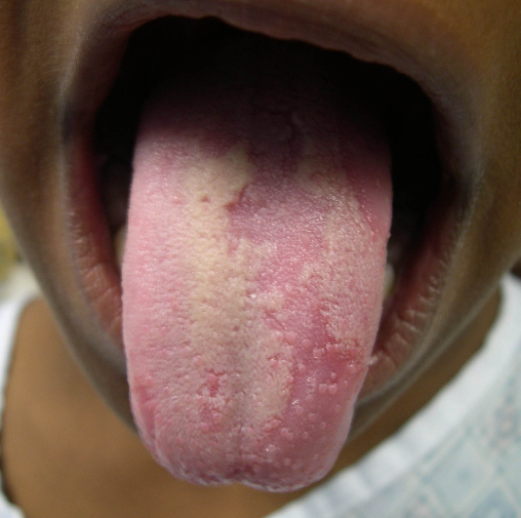Geographic Tongue
(Benign Migratory Glossitis, Erythema Migrans Linguæ)
This is a common condition that causes a characteristic appearance, which experts recognise instantly. The tops of the tongue, sides and occasionally, under-surface of the tongue develop irregular, smooth red areas, which may look like the outline of a map. There are usually wavy, white lines next to the red patches.
The cause is unknown. For reasons as yet not understood the normal top layer of the ‘skin’ of the tongue is not shed evenly. In some parts the ‘skin’ is shed too early and so leaves a red, sore area like a scratch on the skin. Whereas in other areas the skin stays on too long and has a white appearance. The red areas, because they are thin, can sometimes become infected with Thrush (Candida) and so feel sore. Thrush is very common in mouths.
As the red patches are thin and raw, they tend to be sore when eating acidic things like citrus fruit or spicy foods especially chillies. However these do not make the condition worse and you will soon come to notice which particular foods make things worse.
It may be inherited from parents. There may be an allergic component.
It is not thought to be infectious. It is associated rarely with psoriasis. It has no long-term consequences.
Diagnosis can be made just from the appearance. However, various forms of anæmia have to be discounted first.
There is no cure. Sometimes treatments for Thrush can ease the discomfort. You can buy these at the chemist, e.g. miconazole gel.
Other treatments for Geographic Tongue include:
- Anæsthetic & antihistamine mouthwashes
- Oral pain relievers
- Topical Steroids / Corticosteroid rinses
- Topical tacrolimus
- Vitamin B & zinc supplements
- Systemic cyclosporin
You will need to work out for yourself which foods make it worse and avoid them.
Useful Articles & Websites
New Zealand Dermatological Society
British Dental Health Foundation
N Engl J Med 2009. Images in Clinical Medicine. Geographic Tongue.
N Engl J Med 2016. Images in Clinical Medicine. Geographic Tongue.
J Am Acad Dermatol 2010. Migratory Stomatitis (Ectopic Geographic Tongue) on the Floor of the Mouth
Am J Med 2016. Clinical Communication to the Editor. Geographic Tongue
J Clin Diagn Res 2016. Paediatric Geographic Tongue – A Case Report, Review & Recent Updates
J Allergy & Clin Immunol 2017. Image in Allergy. Geographic Tongue
Australian Doctor. Patient Information. Geographic Tongue
American Academy of Oral and Maxillofacial Pathology (2005). Geographic Tongue
BSOM Patient Information Sheet. Geographic Tongue
N Engl J Med 2009. Images in Clinical Medicine. Geographic Tongue.
N Engl J Med 2016. Images in Clinical Medicine. Geographic Tongue.
East & North Hertfordshire NHS Trust. Oral & Maxillofacial Department. Geographic Tongue
Sheffield Teaching Hospitals NHS Foundation Trust. Information for Patients. Geographic Tongue
Wirral University Teaching Hospital NHS Foundation Trust. Information Leaflet. Geographic Tongue




